“If my book has one single message, it is that the initial settlement of Australia, a term that sounds so gentle and benign, was only possible if its First Peoples were first unsettled. Although I have lived all my life on Dja Dja Wurrung Country, it has taken the research for this book to fully bring home the reality that what was done on Country to violently unsettle people verged on genocide. And it has taken me almost a lifetime to become fully aware that Dja Dja Wurrung people and their connections to Country have survived.”
Golding, Barry (with Willman, Clive):Six Peaks Speak- Unsettling Legacies in Southern Dja Dja Wurrung Country, 2024, Common Ground Books , P. 372
Welcome to the June 2025 edition of Localising Leanganook’s e-newsletter. Enjoy our feature article on Barry Golding’s Six Peaks Speak – Celebrating International Mountain Day on Djaara Country
Cheers, Nikki, Keppel, and Laurel
A reminder of Changes to Localising Leanganook activities and e-newsletter
The editing group of Localising Leanganook is making three changes:
- First, re-initiating community conversations in collaboration with other groups. Localising Leanganook community conversations commenced after the Local Lives Global Matters Conference held in Castlemaine almost 10 year s ago, in October 2015, as a way of keeping the momentum going. We are organising a community conversation in August 2025, in collaboration with Castlemaine Free University – more information in our next edition . We welcome your suggestions for future conversations.
- Second, our monthly e-newsletter will focus on a feature article, exploring localisation in greater depth in our our region as well as innovations which challenge existing paradigms, showcase creative and sustainable local initiatives, and which incubate ideas and strategies to strengthen our community connection and resilience.
- Third, we are updating our Localising Leanganook website to incorporate tabs under events and groups headings. This is still a work in progress. A brief description and image for each group and event will be included under the tabs with links to websites and/or Facebook pages, so you can find further information and updates. This will make the newsletter shorter. We welcome your input around suitable group and event descriptions plus images. Contact us via hello@leanganook.org
Here are the heading tabs: Arts and Culture; Food Growing, Farming and Food Security; Ecology and Environment; First Nations; Sustainable Living Resources; Building Community; The Spirit and the Sacred; Democracy and Local Government;Workshops and Courses; Letters; Food for Thought
Feature Article- Barry Golding’s Six Peaks Speak – Celebrating International Mountain Day on Djaara Country
Honorary Professor Barry Golding AM, Federation University, writes:
I had the huge privilege as a State Library Victoria Creative Fellow in 2023. I spent a whole year researching and writing a book about six modest mountains on Country near where I live in central Victoria. It was undertaken with the strong support of DJAARA for the Dja Dja Wurrung Traditional Owners. ‘Six Peaks Speak: Unsettling Legacies in Southern Dja Dja Wurrung Country’ published in 2024 on International Mountain Day (IMD, which is celebrated globally each year on 11 December) is my main tangible outcome. I am hopeful, like DJAARA, that future celebrations of other Australian mountains on Country might become an enduring legacy. This is my story and vision.
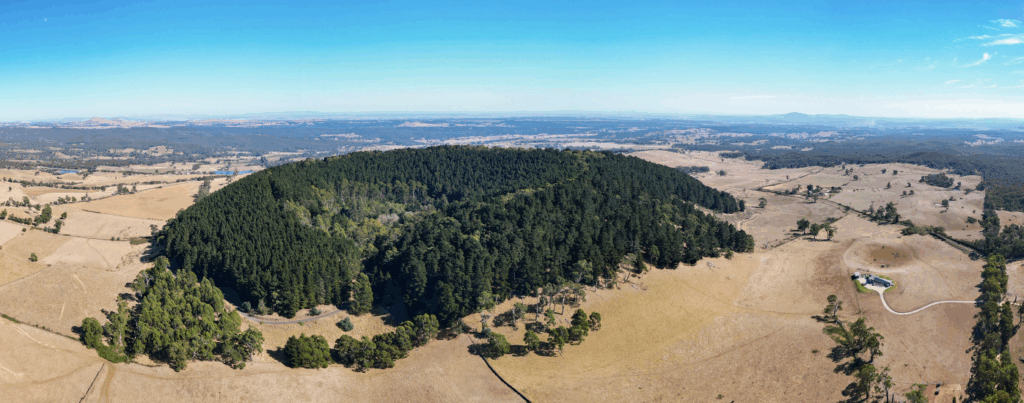
Header image: Lalkambuk / Mount Franklin’s pine covered, breached volcanic crater (Drone Photo: Oliver Zimmermann).
Six Peaks Speak adopted a ground-up, multidisciplinary perspective to tell the story of just six modest mountains out of 22,000 named peaks in Australia, from deep geological time to the present. While the peaks I selected are today called mounts Kooroocheang, Beckworth, Greenock, Tarrengower, Alexander and Franklin, each one also has a fascinating but rarely considered First Nations back story. Written with the invaluable assistance of coauthor, geologist and friend Clive Willman, our book sought to answer the question, ‘How can we help future generations deal with the unsettling legacies of what has happened to mountains?’
Unsettlement
I deliberately included unsettling in the title in our book. It challenges the false assumptions and attitudes in historical sources about the benign nature of ‘settling’, ‘discovery’, ‘exploration’ and ‘pioneering’ in an already comprehensively explored, settled, named and cultured continent. I personally experience the notion of ‘settlement’ in the context of colonization and copious evidence of attempted genocide in Australia as upsetting, disturbing and discomposing. Six Peaks Speak thus upends the comfortable and conventional idea of settling, instead using unsettling as one of its key organizing principles.
Mountains are important sentinels of change in Australian landscapes. All were managed and settled and have recently been unsettled. Few mountains were ‘wilderness’ in the modern sense. Some, like the ancient granite peaks in my home landscape including Dharrang Gauwa (Mt Tarrengower, near Maldon), Nyaninuk (Mt Beckworth, near Clunes) and Liyanganuk (Mt Alexander, near Harcourt) are what remains after hundreds of millions of years of erosion. Others like volcanic Lalkambuk (Mt Franklin, near Daylesford, see Figure 1), Mount Greenock (near Talbot) and Gurutjanga (Mt Kooroocheang, see Figure 4) are relatively recent ‘upstarts’; relatively young scoria cones which built up quite recently and quickly as a consequence of volcanism within the past 4 million years. A recent date for Lalkambuk (meaning ‘split head’) confirms the mountain’s exquisite, breached crater, which Dja Dja Wurrung people called Larne barramul, literally ‘nest of the Emu’, had formed as recently as 110,000 years ago.
This volcanic activity not only created hundreds of elevated scoria cones, which by virtue of their shape came to be known as mammaloid (‘breast-like’) hills and mountains. The lava spread downslope away from the peaks, flowing along valleys in every direction like honey, far and wide, burying gold bearing streams and gravels, typically creating two new streams where there had only been one. It is these fertile and well-watered lava plains and their ‘twin lateral steams’ in western and central Victoria which once supported some of the highest First Nations population densities in inland Australia.
The natural productivity of the rich soils developed on the lava plains was enhanced by regular and systematic First Nations burning, creating extensive grasslands carpeted by nutritious murnong (Yam Daisy) and grazed by countless herbivores. All of this changed in 1838 when squatters overlanded with sheep, forcefully and sometimes violently removing and excluding First People from Country. Settlement of Australia, was only possible if First Peoples were first unsettled. It is this unsettlement and what followed that each of the six mountains featured in our book have borne witness to.
Modest Mountains & Hills: All Different
Mountains, hills and the public reserves that sometimes surround them need not be as high or as expansive as those in the Australian Alps to be impactful, embraced and cared for by the local community, including by First Nations peoples. The locally loved Mt Jeffcott near Donald, where I was born in northern Dja Dja Wurrung Country in north western Victoria, is only 252 metres above sea level and 100 metres above the surrounding plain. The nearby rocky summit of the locally adored Mt Wycheproof, which stands just 42 metres above the surrounding plain and only 148 metres above sea level, is purported to be the smallest registered mountain in the world.
We often focus on a small number of high, iconic mountains which are on publicly reserved land, in part for their utility associated with nature conservation, but particularly for human visitation, such as providing opportunities to enjoy their elevated and scenic views, rock climbing, walking, snow skiing or enjoying plants and wildlife. It is useful and important as part of responsibly managing Australia’s 22,000 named peaks to better understand how mountains and the endemic species which they sometimes serve as refuges for, were created over Deep Time and settled by First People. While many smaller mountains and most hills in Australia are on private land, all have deep histories and cultural associations including with First Peoples, not only via their original names or as places to gather food, but as special and sacred places to assemble and conduct ceremony.
One thing I’ve realised since carefully studying these six peaks from a multidisciplinary, Deep Time perspective is that that all mountains are individual and different. Being in the landscape for much longer than humans, each mountain has been subjected to a range of unique influences and changes over very long time periods, including by erosion and deposition, changes in climate, volcanism and earth movement.
Some of these influences have been preserved on our peaks; others have been erased or hidden. Every gully and rocky outcrop on each peak is subtly different because of differences in slope, altitude, aspect, ecological and geological history. As a consequence, the animals, plants and fungi that call our peaks home are everywhere subtly different, something which First Peoples came to know and understand in order to live sustainably and thrive on and around mountains in Australia for at least 60,000 years.
Since writing Six Peaks Speak, I have come across palimpsest theory. The theory posits that objects and landscapes (including mountains) can be thought of as palimpsests (literally and metaphorically), able to concurrently contain and preserve evidence of multiple meanings as each new meaning is inscribed over past ones. The theory anticipates that some meanings may be conspicuous, while others might be erased or hidden. I suggest that the theory will also be useful in the future for identifying and restoring ancient First Nations associations on Country. It will also be useful for dealing with the layered, contested and evolving meanings and impact of mineral, sand and stone extraction, which often occurs on and around mountains and hills.
In order to illustrate what I mean, take a close look at the Digital Elevation Model (DEM) map (see Figure 2, below) that Clive Willman created for our book, which features the topography of the Six Peaks Region and its relationship to geology. Only six mountains featured in our book are named on this map, amongst the hundreds of other hills and mountains in this 80 x 80 km area. The grey areas are mostly ancient sedimentary rocks, which from the 1850s became ‘gold country’. Being relatively soft and erodible these areas form rugged, hilly terrain with few large mountains.
What is particularly striking are the prominent hornfels hills around most of the granite margins. The hornfels is more resistant to erosion since it was baked hard (metamorphosed) at great depth by the molten granite. Pink granitic areas feature ancient, often prominent mountains (similar to Mt Buffalo in Victoria’s northeast) and rolling hills. Pale brown areas are relatively flat and now fertile, very recent volcanic plains dotted with numerous elevated scoria cones (orange) and other eruption centres (black dots).
At this scale the relationship between topography, drainage and geology becomes strikingly obvious. The two 8-km radius circles enclose the 1840/1 Neura Mong and 1841/9 Loddon (Franklinford) Aboriginal Protectorates, sited on less fertile country of less interest to the squatting unsettlers than the first-seized volcanic plains.

Figure 2: Digital Elevation Model (DEM) showing the topography of the Six Peaks Region and relationship to geology (Map Credit: Clive Willman).
Zooming in to the area towards the north of the map, the geological map of the area around Mount Tarrengower (Figure 3) which includes roads, towns and mines illustrates the close relationship between post-contact settlement patterns and geology on a smaller scale. The western flank of Mount Tarrengower, being granite, has no mines and sparse settlement. By contrast, the summit of Mt Tarrengower is composed of resistant hornfels. All of the gold occurred either in the hornfels or within the ancient, folded sediments, unsurprisingly where the historic mining town of Maldon is located. While Cairn Curran Reservoir now obscures most of the evidence, the Loddon River has relatively recently been forced change its course by the basaltic lava.

Figure 3: Geological map of the area around Dharrang Gauwa / Mt Tarrengower (Map Credit, Clive Willman).
What is illustrated in these few examples can be extrapolated to most mountains and hills in Australia. They are elevated peaks today for a very good, often geological reason: either because they were more resistant to erosion over Deep Time, or because they have been created relatively recently by volcanism or earth movement. The ecological communities and patterns of human settlement on and around most mountains, pre- and post-contact, are also determined largely by geology.
International Mountain Day
While I was in Japan in 2023 taking a break from writing our book about six peaks, I discovered that Japan was one of very few countries in the world to actively adopt and celebrate the UNESCO International Mountain Day. The specific aim of its celebration in Japan since 2016 has been to encourage Japanese people to pay homage to and appreciate blessings from mountains, which are acknowledged as an important part of Japanese culture.
International Mountain Day was originally designated in 2003 by the United Nations as 11 December, to highlight the importance of sustainable mountain development. In Japan, 11 August was chosen instead, in part because some mountainous regions already celebrated their mountains on that day. It was also because the kanji character for eight (八) resembles a mountain, and the character for eleven looks something like two trees, symbolizing the landscape.
I wondered where the idea for celebrating International Mountain Day originated. I discovered that in autumn of 1838, women from one small college in the United States began an annual tradition of taking the day off and climbing nearby Mount Holyoke, which their College was named after. This tradition evolved into Mountain Day in several other US colleges, to eventually become International Mountain Day.
I discovered that 17,000 km away, at the same time in the same year, on the other side of the planet, squatter John Hepburn was forcefully removing Dja Dja Wurrung traditional owners from their carefully managed grasslands in Australia and renaming Gurutjanga (Mount Kooroocheang, see Figure 4), one of the six mountains featured in our book. For thousands of years, Dja Dja Wurrung people had been living semi-permanently on the fertile volcanic plains, at a place below the peak that Hepburn acknowledged was their ‘favourite place’. Countless generations had assembled and conducted ceremony here on a unique, purpose built 75 metre diameter earth ring, as well as in the Larni barramal crater surrounded by Lalkambuk’s ‘split head’ mountain rim, today called Mt Franklin.

Figure 4: Gurutjanga / Mt Kooroocheang in late summer 2023 (Drone Photo: Oliver Zimmermann).
In Hepburn’s eyes, Aboriginal people were simply getting in the way: like most other squatters, Hepburn behaved as if he owned the land, rather than just having a lease from the Crown for grazing his sheep. He was unaware that the people he was forcefully and sometimes violently removing for his sheep were largely responsible for creating and maintaining its agricultural productivity.
As Robert Lewis put it in Environmental history of Australia, squatters, who I accurately call ‘unsettlers’ in my book, took the view that since First Peoples ‘… seemed to be living off [the land] but not being productive, [they] did not have a rightful claim to it’. Violence was perceived as justified and necessary as part of the unsettling process whenever Dja Dja Wurrung people resisted the invasion.
The Sydney Herald in the same year, 1838, justified the violent seizure of land in Australia. They did this by comparing Aboriginal Australians with First Nations people in America in the most negative of ways, using claims that we now know are patently false, conveniently misconstrued and inhumane.
The American Indians were divided into Nations, having fixed localities – they cultivated the ground, and understood the right of property. Not so, however the natives of New Holland. This vast country was to them a common. They bestowed no labor upon the land – their ownership, their right was nothing more than the Emu or Kangaroo. They bestowed no labor upon the land, and that – and that only – it is which gives a right of property in it. (7 Nov 1838, p.2)
Given these false claims, I wondered how Mount Holyoke College in the US came to be named. I discovered that the mountain’s First Nations name was changed after English colonist Elizur Holyoke arrived in Massachusetts Bay Colony in 1637 or 1638. Like John Hepburn 200 year later, he had violently seized Nonotuck First Nations land to enhance his personal wealth. Renaming mountains was an important part of the colonial ‘settling’ agenda.
There were so many serendipitous parallels here of history repeating itself. And I figured celebrating International Mountain Day (IMD) on Dja Dja Wurrung Country in 2024 and beyond might provide a way of ‘thinking globally but acting locally’: of telling the story of mountains on Country. In the process of celebration, it would also provide an opportunity, in an era of truth telling, to expose many of the uncomfortable and lesser known legacies of how ‘things came to be like this’, and find ways in Australia of healing Country together as a community.
On IMD in 2023 I spoke about my Six Peaks Speak project and my future vision for celebrating International Mountain Day on Country. I invited several organisations which I thought might usefully collaborate. The 2024 IMD working party was headed up by DJAARA through its CEO Rodney Carter, also including Outdoors Victoria and the local Great Dividing Trail Association.
The idea of celebrating IMD on Country in 2024 was taken up enthusiastically by DJAARA. In their words:
Our Ancestors have told us of our beginning. It is ancient, and those stories talk of all creation through their Martinga Guli (Ancestral Spirits). On mountains, where colonial development is more limited, it is easier to hear their whispers, the language of Country. The wider community also feels this spirit that we nurture today through practising our Culture. International Mountain Day is a day to come together as one People and connect with Country. When we are spiritually connected to Country, we can feel its tears, we can hear its voice and continue to share its stories for thousands of generations to come.
On the morning on 11 December 2024, DJAARA warmly invited the community to ‘Immerse yourself in Dja Dja Wurrung Culture, share in our vision of caring for Country and the importance of connecting with nature for the health and wellbeing of all People’. The ‘Caring for Country: Caring for People’ celebration inside the Lalgumbuk (Mt Franklin) crater included a smoking and welcome, storytelling and truth telling around the campfire, cultural activities to connect with Country including nature walks, cultural workshops and presentations, sensing Country and mindfulness.
In the week leading up to 11 December, the Great Dividing Trail Association organized interpretive walks on each of the mountains included in my six peaks study. In each of the towns closest to the mountains (Kingston, Clunes, Maryborough, Maldon, Castlemaine and Daylesford), community presentations gave local people an opportunity to learn more about their local mountains: in effect to enable each of the ‘peaks to speak’ and tell their seldom heard stories.
My future vision is for International Mountain Day, 11 December each year, to become an important day for people and communities in many other parts of Australia, following on from DJAARA’s 2024 generous example. I envisage people gathering, celebrating and engaging in truth and storytelling with First Peoples about many other special hills and mountains, big and small in all parts of Australia. In the process, I anticipate we will all come to understand that mountains are important for a whole host of reasons, aside from our visitation.
These are special places where clouds gather, eagles soar, rivers rise, trees sequester carbon, people re-create, habitat recovers and fungi flourish. Mountains are elevated places for the planet, body and the soul; to get up above the rest of the world, to contemplate and get in touch with our past, present and shared future. It is appropriate that I close by sharing DJAARA’s vision for IMD, below, with you. I hope others around Australia will take up this vision with other First Peoples and celebrate International Mountain Day on your own special mountains and hills.
—————————————–
DJAARA Vision statement for International Mountain Day
- For Dja Dja Wurrung People, our peaks provide a vantage for many reasons: we see further across Country, send signals through boort (smoke), and nestle secluded at their sides for yapenya (ceremony). Our mountains are significant in many ways. They hold murrun (spirit). They are places of gathering. They are the larni (homes) of our Ancestors, People, animals, plants and water.
- Dja Dja Wurrung People have actively tended Djandak (Dja Dja Wurrung Country) for many thousands of years. It’s impossible to separate Country from our identity and cultural practice. Caring for Country is the living essence that is shared between people and place.
- As we barring (journey) through Country, our peaks guide us, just as they guide gatjin (water) across Country for its plants and animals, connecting through our songs and stories to all at Country. We have passed traditional knowledge down through generations to maintain our cultural identity.
- Although colonisation disrupted our Ancestors’ interaction with Djandak and way of life, we have never lost our connection with Djandak.
- With colonisation, Dja Dja Wurrung People were prevented from practising Culture. Meanwhile, waves of exploitation and Western land-management practices swept Djandak – including mining, clear felling, land clearing and mismanagement.
- DJAARA has a long-term vision for healthy Country, expressed in our Dhelkunya Dja Healthy Country Plan, and through our strategies: Forest Gardening, Climate Change, Renewable Energy, Water and Fire.
- Our strategies are generational: designed to inform policy and active management for the next 100 years. Healing Country will take time. We plant seeds today, even when we know that we will not sit beside them in the shade of those trees’. Our work is for the generations who will come after us.
- Our Ancestors have told us of our beginning. It is ancient, and those stories talk of all creation through their Martinga Guli (Ancestral Spirits). At mountains, where colonial development is more limited, it is easier to hear their whispers, the language of Country. The wider community also feels this spirit that we nurture today through practising our Culture.
- International Mountain Day is a day to come together as one People and connect with Country. When we are spiritually connected to Country, we can feel its tears, we can hear its voice and continue to share its stories for thousands of generations to come.
- Dhelkup Murrupuk, we give good spirit.
Further information: You can find additional information about the Six Peaks Speak book and its availability via https://barrygoanna.com/7-2/
Barry Golding researched and wrote Six Peaks Speak from Dja Dja Wurrung Country in Central Victoria in 2023 as a State Library Victoria Creative Fellow. He self-describes as a ground-up, community-oriented, polymathic, place-based story teller. His degrees span four disciplines: geology, arts, environmental sciences and education. Barry has researched and published internationally in vocational, adult and community learning including about community Men’s Sheds. Barry is Honorary Patron of the Australian Men’s Shed Association, former President of Adult Learning Australia and in 2016 was awarded the Member of the Order of Australia (AM).
Clive Willman is a geologist with a long and distinguished career in the Victorian State Government and in the Australian gold mining and exploration industry. Clive has developed a YouTube Channel called ‘Geology Films’.
Some Upcoming Events in our Region for June 2025
Newstead Arts Hub- Fundraising Trivia Night
When: Saturday May 31, 6.30pm
Central Vic Indigenous Film Festival
–
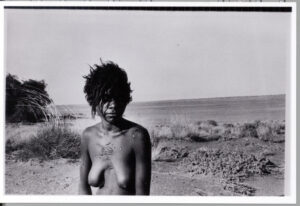
As part of National Reconciliation week, films will be screened in Castlemaine, Hepburn Springs, Yandoit, Bendigo and more.
Here’s the program link: https://www.bendigo.vic.gov.au/sites/default/files/2025-05/City-Greater-Bendigo-CVIFF-program-2025.pdf
Yandoit Cultural will screen CONTACT on Sunday June 1st at 5pm- https://yandoitcultural.org/
Radius Gallery, Main Rd Hepburn Springs, will screen Returning our Ancestors , on Thursday May 29th, 5.30pm for 6.00pm start – https://events.humanitix.com/returning-our-ancestors-film-screening
Community Meeting re Hepburn Shire Council’s Budget
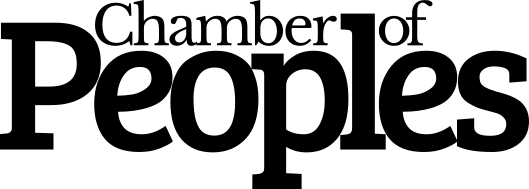
The Chamber of Peoples has partnered with Hepburn Matters to host an event related to the Hepburn Shire Council’s budget and financial position. Come along and contribute to discussion. A summary of diverse views will be provided to Council.
When: Tuesday, 3 June 2025, 6:00-7:30 pm
Where: Glenlyon Hall – Daylesford-Malmsbury Rd, Glenlyon
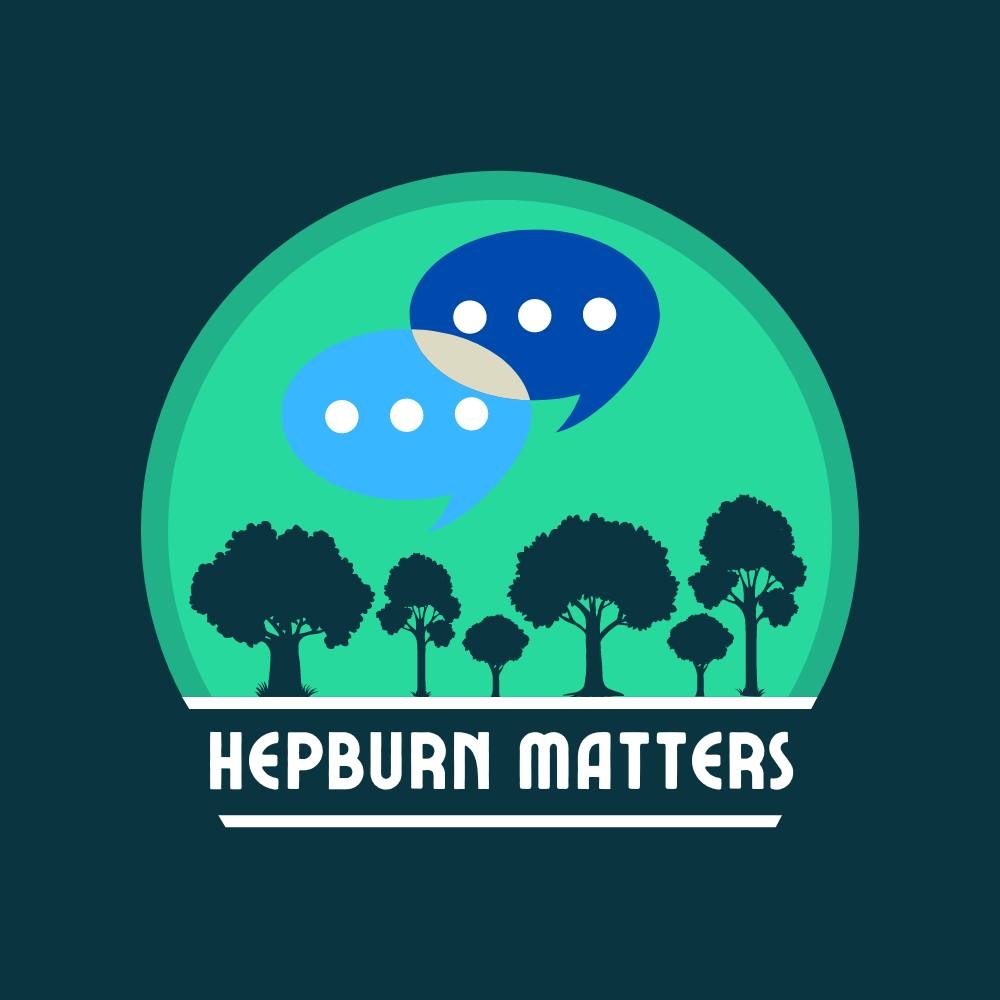
Who: Hepburn Shire residents welcome, hosted by Hepburn Matters and the Hepburn Chamber of Peoples
Why: To discuss concerns of residents about the Hepburn Shire Council’s Draft Budget, financial position, and service delivery within the Shire.
Come along and let your voice be heard!
Creating Circular Public Events- Sustainability Victoria
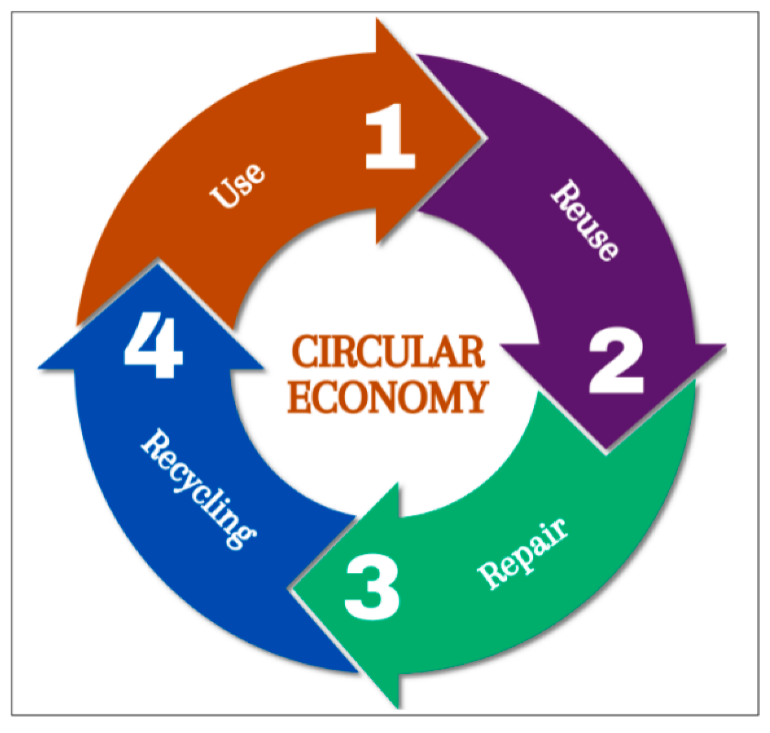
Following the success of our recent Creating Circular Public Events webinar, Sustainability Victoria will be presenting a series of fortnightly community circular economy webinars in May and June. Building on knowledge and examples from the Community Circular Economy Guides, Circular Economy Communities Fund and leading Not for Profit and Community Volunteer groups, this series invites attendees to learn the ins and outs of getting their own project off the ground through the lens of the three circular economy principles: Circulate materials at their highest value; Eliminate waste and pollution; Regenerate natural systems.
SAVE THE DATES for webinar 3 in this series: Webinar 3: Regenerate natural systems – Wednesday 11 June, 12:00pm
Castlemaine Community Coop – Celebration and Opening of Debenture Offer for Hub Foundation building

When and Where: Sunday 1st June at 4.30pm – a celebration & opening of the debenture offer, at Shedshaker.
Castlemaine Community Co-operative wants to buy our valuable real estate assets and make them community owned for good! We have negotiated a price for the Hub on Barker Street.We want to buy it using a type of loan from members (debentures in 5, 10 or 15 year terms). The building is profitable enough to provide investors an annual return. The Coop is seeking people to join – as a member, a donor or investor!
For more information: www.castlemaine.coop
Castlemaine Jazz Festival
When: Kings birthday weekend, June 5-8th

For more info, program and bookings:
https://www.castlemainejazzfestival.com.au/
Yandoit Cultural – An Afternoon with Daylesford Musical Couple- Alex and Emily

A warm intimate musical afternoon as singer-songwriter Emily Davis and ARIA-nominated classical guitarist Alex Tsiboulski share their long-time favourites and their most recent work, on Saturday June 15th at 3pm.
Emily, a singer/songwriter with three albums under her belt, is a performer of rare communicative ability and emotion. Classical guitar virtuoso Alex Tsiboulski is an award-winning performer and recording artist. Recently returned from a European playing, recording and teaching tour, he will be playing a selection of classical guitar favourites alongside fresh recent compositions by leading composers.
A rare insight into a couple making music in different genres, bound by an admiration for each other’s emotional and musical journeys. Early bird discount 30% for bookings before June 6. Promo code earlybird77
BOOKINGS: https://www.trybooking.com/DCFTG
Mt Alexander Sustainability Group (MASG)- Reconnecting & Saying Thanks
As most Localising Leanganook readers would already know, MASG (Mount Alexander Sustainability Group) came to life nearly 20 years ago, as a group of locals gathered around a shared goal: to take meaningful, community-led action on climate change right here in Mount Alexander Shire. Since then, we’ve worked alongside our community to reduce waste, support renewable energy, improve energy efficiency, and promote sustainable agriculture.

We’ve had some amazing highs—like the Repair Café, Wash Against Waste Trailer, Sustainable Fashion Show, and the Healthy Soils project—and, like many community groups, some tougher times too, especially during and after the pandemic. Through it all, your support has kept us going. We’re deeply grateful for the time, energy and heart this community has put into creating a more sustainable future. Thank you.
Now, this June, we’re getting back out into the community to reconnect. We’d love to hear what’s going on for you around sustainability and regenerative living—whether you’re involved in a project, curious about what’s happening locally, or just wondering where to start. We’re here for all of it. We understand that a lot of what we call “sustainability” today is what our parents and grandparents simply called “getting by”—saving what could be useful, making things last, living within the limits of what was available. It’s great to see these ways of living being reclaimed and reimagined—from composting projects like YIMBY, to sewing sessions at The Good Op-Shop, to energy workshops by the West End Resilience Group.
These aren’t MASG-led initiatives, but they reflect the culture of care, creativity and climate action this community has been growing for two decades. We’re proud to have played a part in that. So, if you see our volunteers or staff out and about this month, come say hello. Ask questions, share ideas—or just have a chat. And if you’re keen to support local climate action, consider becoming a MASG member. It’s a small thing that helps in a big way.
Membership means voting rights and our e-newsletter, but more than that, it’s about being part of a community that’s working together for a future where everyone’s needs are met—now and into the future. Visit www.masg.org.au/get-involved or scan the QR code to join us.
Regenerating Communities Conference- Call for Participation
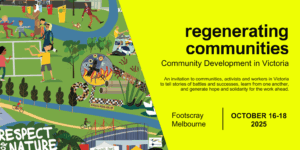
A Victorian Conference on Community Development on October 2025: We invite all engaged in community-based and community-oriented work to join us in Footscray, Naarm/Melbourne, for a much-needed gathering on Community Development (CD). After what feels like a hibernation for CD practitioners, this is our chance to reconnect, share stories, and reaffirm our commitment to working with communities—not just for or ‘to’ them.
Call for participation! Whether you bring a formal paper, a workshop, a lightning talk, a panel discussion, a yarning circle, a performance, a poster display or stall holder, all contributions are welcome—especially those that provoke, inspire, and challenge. All conference proposals (max. 250 words) should be in by 30th June 2025. You will receive a response within two weeks after receipt of your proposal. Submit at the conference website http://regeneratingcommunities.net/
Castlemaine Documentary Film Festival
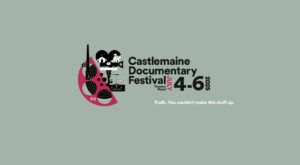
The Castlemaine Documentary Festival returns mid-winter for another non-stop weekend of bold, boundary-pushing nonfiction film. From Friday 4 to Sunday 6 July, audiences will once again gather at the iconic Theatre Royal to experience stories that surprise, provoke, and connect.
This year’s theme, ‘Truth, you couldn’t make this stuff up,’ celebrates the genre-hopping, utterly surprising, and sometimes strange, power of real-life stories. Join us for three days of groundbreaking nonfiction cinema, live music performances, world premieres and the ever-popular LOCALS showcase of regional short films. Our full program is out now! Head to www.cdocff.com.au
New Economy Network Conference- Pathways to Thriving World- Submit your Proposal
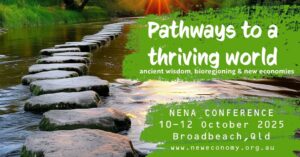
SUBMIT YOUR PROPOSAL AND JOIN US AT THE NENA CONFERENCE IN OCTOBER!
The New Economy Network Australia (NENA) invites proposals for our 2025 National Conference, which will bring together practitioners, academics, policymakers, and activists to explore how ancient wisdom and innovative economic approaches can create thriving, sustainable, and inclusive societies.
The conference will be held at the Broadbeach Cultural Centre on the Gold Coast (Queensland), Friday 10th to Sunday 12th October 2025.
We welcome submissions across diverse formats, including practitioner presentations, academic research paper presentations, panel discussions, workshops, and experiential activities. READ MORE about the Conference Themes, and SUBMIT YOUR PROPOSAL by July 1st via our ONLINE FORM HERE
MORE INFORMATION: Questions? please get in touch at nena@neweconomy.org.au
My Home Network- Update

Lots happening with My Home Network including: Housing forum; public housing movable units; household energy efficiency program; the economic case for community land trusts; rooms to rent in shared living environment; older women in co-housing; tenants’ rights working group; secondary dwellings; vacant dwellings; tiny homes on wheels; fundraising for un-housed; rough sleeper action group; Mt Alexander Affordable Housing Trust; and home-sharers.
For more information: https://dhelkayahealth.org.au/wp-content/uploads/2025/05/MHN-Update-May-2025-1.pdf
Food for Thought
Is a River Alive?An Interview with Robert Macfarlane: https://emergencemagazine.org/conversation/is-a-river-alive/

![[ Random Image ]](https://leanganook.org/images/image_12.jpeg)
